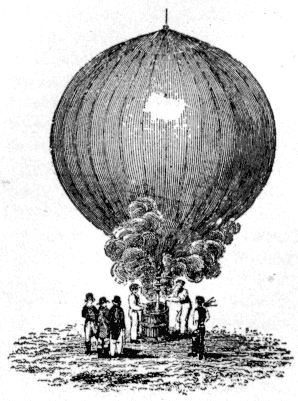Hydrogen
Today, hydrogen -- in 1783. The University of Houston's College of Engineering presents this series about the machines that make our civilization run, and the people whose ingenuity created them.
Hydrogen is a wonderful mouthful of a word. Antoine Lavoisier named it in 1783, after he realized that it makes water when it's burned in oxygen. Hydrogen means "maker of water" in Greek. But the element had been known before that. The sixteenth-century Swiss alchemist Paracelsus separated it, but he seems to have confused it with other flammable gases.
Hydrogen came to public attention seventeen years before Lavoisier named it. The English chemist Henry Cavendish identified it. He thought it was a kind of flammable, or phlogisticated, air. Phlogiston was the old alchemical principle of combustion. By 1783 Cavendish had also seen that hydrogen formed water when it was burned; but he didn't realize that oxygen was involved, too.
That was also the year the French began making balloon ascents in Paris. The Montgolfier brothers used hot air in the first manned balloon. Hot air is easy enough to come by (as I suppose we all know too well) but heated air is only a little less dense than the cool air around it. Whatever people thought hydrogen was, they knew it was very light -- about 1/15th the density of air. It had terrific lifting power in a balloon.
The champion of hydrogen-filled balloons was the French natural philosopher Alexandre Charles. He flew an unmanned hydrogen balloon just before the Montgolfiers' flight. He flew a manned one only 3-1/2 months afterward. He invented a hydrogen generator that mixed huge quantities of sulfuric acid with iron filings.
London sneered at French balloons. But the intellectual climate was different further to the north. In Birmingham, the founders of the Industrial Revolution met in a club called the Lunar Society. These were people like Watt, Priestley, Wedgwood, Boulton, and Erasmus Darwin. Science was no sport for this serious group. Rather, it was a means for creating social reform. And they saw scientific possibilities in the French balloons.
In 1784 Watt and Boulton built an unmanned paper balloon, filled it with air and hydrogen, and sent it up on a timed fuse. They hoped to learn whether the reverberating sound of thunder was the result of repeated claps or of echoes. Would a single explosion result in reverberation? The experiment was inconclusive, but the explosion was apparently a grand and soul-satisfying one.
And so the new sport of ballooning put words like inflammable air and phlogiston on every tongue. These huge hydrogen-filled spheres dressed the sky in fantastic colors. They caught the public's fancy and hurried chemistry out of the alchemical laboratory. Balloons helped tie chemistry to the high technology of the Industrial Revolution. Those wonderful and seemingly purposeless playthings remind us that you and I are part of the process we call science, even when we only sit upon the sidelines.
I'm John Lienhard, at the University of Houston, where we're interested in the way inventive minds work.
(Theme music)
Rolt, L. T. C., The Aeronauts: A History of Ballooning 1783-1903. New York: Walker and Company, 1966.
This is a revised version of Episode No. 147.

Alexandre Charles' hydrogen balloon
From the 1897 Encyclopaedia Brittanica

Model of the Montgolfier Brothers' balloon, National Air and Space Museum